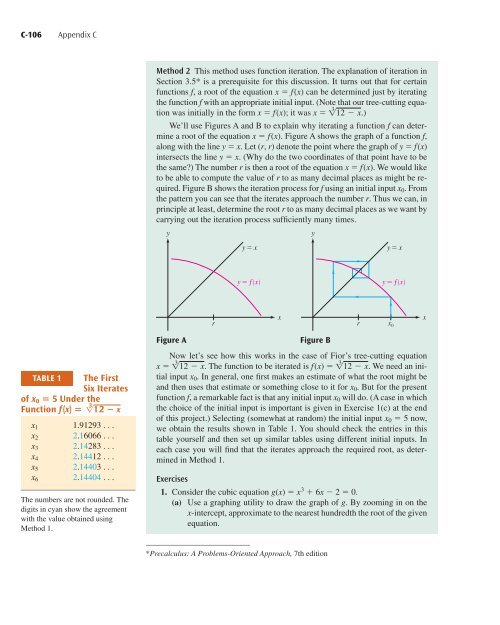You also want an ePaper? Increase the reach of your titles
YUMPU automatically turns print PDFs into web optimized ePapers that Google loves.
C-106 Appendix C<br />
Method 2 This method uses function iteration. The explanation of iteration in<br />
Section 3.5* is a prerequisite for this discussion. It turns out that for certain<br />
functions f, a root of the equation x f(x) can be determined just by iterating<br />
the function f with an appropriate initial input. (Note that our tree-cutting equation<br />
was initially in the form x f(x); it was x 1 3 12 x. )<br />
We’ll use Figures A and B to explain why iterating a function f can determine<br />
a root of the equation x f(x). Figure A shows the graph of a function f,<br />
along with the line y x. Let (r, r) denote the point where the graph of y f(x)<br />
intersects the line y x. (Why do the two coordinates of that point have to be<br />
the same?) The number r is then a root of the equation x f(x). We would like<br />
to be able to compute the value of r to as many decimal places as might be required.<br />
Figure B shows the iteration process for f using an initial input x 0 . From<br />
the pattern you can see that the iterates approach the number r. Thus we can, in<br />
principle at least, determine the root r to as many decimal places as we want by<br />
carrying out the iteration process sufficiently many times.<br />
y<br />
y=x<br />
y<br />
y=x<br />
y=ƒ<br />
y=ƒ<br />
r<br />
x<br />
r<br />
x¸<br />
x<br />
TABLE 1 The First<br />
Six Iterates<br />
of x 0 5 Under the<br />
3<br />
Function f(x) 112 x<br />
x 1 1.91293 . . .<br />
x 2 2.16066 . . .<br />
x 3 2.14283 . . .<br />
x 4 2.14412 . . .<br />
x 5 2.14403 ...<br />
x 6 2.14404 ...<br />
The numbers are not rounded. The<br />
digits in cyan show the agreement<br />
with the value obtained using<br />
Method 1.<br />
Figure A<br />
Figure B<br />
Now let’s see how this works in the case of Fior’s tree-cutting equation<br />
x 1 3 12 x. The function to be iterated is f(x) 1 3 12 x. We need an initial<br />
input x 0 . In general, one first makes an estimate of what the root might be<br />
and then uses that estimate or something close to it for x 0 . But for the present<br />
function f, a remarkable fact is that any initial input x 0 will do. (A case in which<br />
the choice of the initial input is important is given in Exercise 1(c) at the end<br />
of this project.) Selecting (somewhat at random) the initial input x 0 5 now,<br />
we obtain the results shown in Table 1. You should check the entries in this<br />
table yourself and then set up similar tables using different initial inputs. In<br />
each case you will find that the iterates approach the required root, as determined<br />
in Method 1.<br />
Exercises<br />
1. Consider the cubic equation g(x) x 3 6x 2 0.<br />
(a) Use a graphing utility to draw the graph of g. By zooming in on the<br />
x-intercept, approximate to the nearest hundredth the root of the given<br />
equation.<br />
*Precalculus: A Problems-Oriented Approach, 7th edition
















